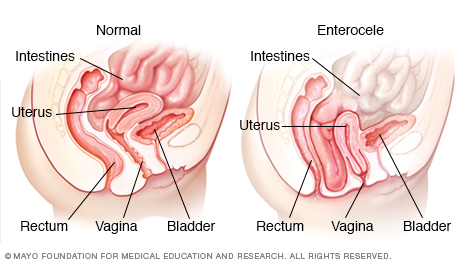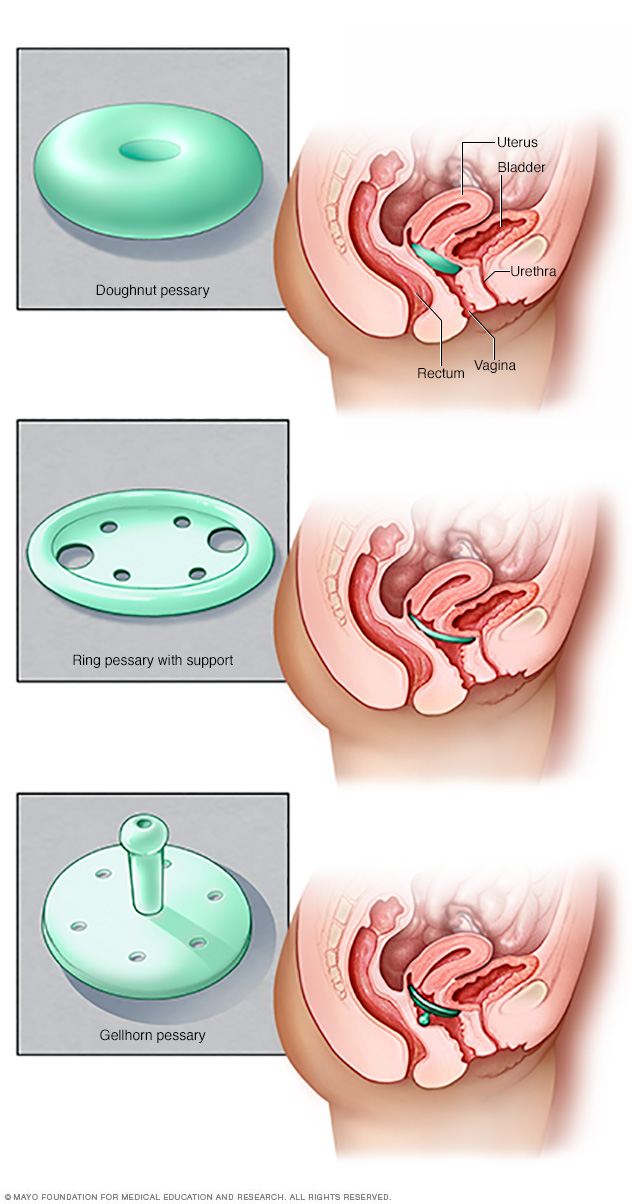Small bowel prolapse, also called enterocele (EN-tur-o-seel), occurs when the small intestine (small bowel) descends into the lower pelvic cavity and pushes at the top part of the vagina, creating a bulge. The word "prolapse" means to slip or fall out of place.
Childbirth, aging and other processes that put pressure on your pelvic floor may weaken the muscles and ligaments that support pelvic organs, making small bowel prolapse more likely to occur.
To manage small bowel prolapse, self-care measures and other nonsurgical options are often effective. In severe cases, you may need surgery to fix the prolapse.

Small bowel prolapse (enterocele) occurs when muscles and tissues that hold the intestines (small bowel) in place inside the pelvic cavity weaken, causing the small bowel to descend and bulge into the vagina.
Symptoms
Mild small bowel prolapse may produce no signs or symptoms. However, if you have significant prolapse, you might experience:
- A pulling sensation in your pelvis that eases when you lie down
- A feeling of pelvic fullness, pressure or pain
- Low back pain that eases when you lie down
- A soft bulge of tissue in your vagina
- Vaginal discomfort and painful intercourse (dyspareunia)
Many women with small bowel prolapse also experience prolapse of other pelvic organs, such as the bladder, uterus or rectum.
When to see a doctor
See your doctor if you develop signs or symptoms of prolapse that bother you.
Causes
Increased pressure on the pelvic floor is the main reason for any form of pelvic organ prolapse. Conditions and activities that can cause or contribute to small bowel prolapse or other types of prolapse include:
- Pregnancy and childbirth
- Chronic constipation or straining with bowel movements
- Chronic cough or bronchitis
- Repeated heavy lifting
- Being overweight or obese
Pregnancy and childbirth
Pregnancy and childbirth are the most common causes of pelvic organ prolapse. The muscles, ligaments and fascia that hold and support your vagina stretch and weaken during pregnancy, labor and delivery.
Not everyone who has had a baby develops pelvic organ prolapse. Some women have very strong supporting muscles, ligaments and fascia in the pelvis and never have a problem. It's also possible for a woman who's never had a baby to develop pelvic organ prolapse.
Risk factors
Factors that increase your risk of developing small bowel prolapse include:
- Pregnancy and childbirth. Vaginal delivery of one or more children contributes to the weakening of your pelvic floor support structures, increasing your risk of prolapse. The more pregnancies you have, the greater your risk of developing any type of pelvic organ prolapse. Women who have only cesarean deliveries are less likely to develop prolapse.
- Age. Small bowel prolapse and other types of pelvic organ prolapse occur more often with increasing age. As you get older, you tend to lose muscle mass and muscle strength — in your pelvic muscles as well as other muscles.
- Pelvic surgery. Removal of your uterus (hysterectomy) or surgical procedures to treat incontinence may increase your risk of developing small bowel prolapse.
- Increased abdominal pressure. Being overweight increases pressure inside your abdomen, which increases your risk of developing small bowel prolapse. Other factors that increase pressure include ongoing (chronic) cough and straining during bowel movements.
- Smoking. Smoking is associated with developing prolapse because smokers frequently cough, increasing abdominal pressure.
- Race. For unknown reasons, Hispanic and white women are at higher risk of developing pelvic organ prolapse.
- Connective tissue disorders. You may be genetically prone to prolapse due to weaker connective tissues in your pelvic area, making you naturally more susceptible to small bowel prolapse and other types of pelvic organ prolapse.
Prevention
You may be able to lower your chances of small bowel prolapse with these strategies:
- Maintain a healthy weight. If you're overweight, losing some weight can decrease the pressure inside your abdomen.
- Prevent constipation. Eat high-fiber foods, drink plenty of fluids and exercise regularly to help prevent having to strain during bowel movements.
- Treat a chronic cough. Constant coughing increases abdominal pressure. See your doctor to ask about treatment if you have an ongoing (chronic) cough.
- Quit smoking. Smoking contributes to chronic coughing.
- Avoid heavy lifting. Lifting heavy objects increases abdominal pressure.
Diagnosis
To confirm a diagnosis of small bowel prolapse, your doctor performs a pelvic exam. During the exam, your doctor may ask you to take a deep breath and hold it while bearing down like you're having a bowel movement (Valsalva maneuver), which is likely to cause the prolapsed small bowel to bulge downward. If your doctor can't verify that you have a prolapse while you're lying on the exam table, he or she may repeat the exam while you're standing.
Treatment
Small bowel prolapse typically doesn't need treatment if the symptoms don't trouble you. Surgery may be effective if you have advanced prolapse with bothersome symptoms. Nonsurgical approaches are available if you wish to avoid surgery, if surgery would be too risky or if you want to become pregnant in the future.
Treatment options for small bowel prolapse include:
- Observation. If your prolapse causes few or no obvious symptoms, you don't need treatment. Simple self-care measures, such as performing exercises called Kegel exercises to strengthen your pelvic muscles, may provide symptom relief. Avoiding heavy lifting and constipation may reduce the likelihood of worsening your prolapse.
- Pessary. A silicone, plastic or rubber device inserted into your vagina supports the bulging tissue. Pessaries come in a variety of styles and sizes. Finding the right one involves some trial and error. Your doctor measures and fits you for the device, and you learn how to insert, remove and clean it.
-
Surgery. A surgeon can perform surgery to repair the prolapse through the vagina or abdomen, with or without robotic assistance. During the procedure, your surgeon moves the prolapsed small bowel back into place and tightens the connective tissue of your pelvic floor. Sometimes, small portions of synthetic mesh may be used to help support weakened tissues.
A small bowel prolapse usually doesn't recur. However, further injury to the pelvic floor can happen with increased pelvic pressure, for instance with constipation, coughing, obesity or heavy lifting.

Pessaries come in many shapes and sizes. The device fits into the vagina and provides support to vaginal tissues affected by pelvic organ prolapse. Your health care provider can fit you for a pessary and help you decide which type would best suit your needs.
Lifestyle and home remedies
Depending on the severity of your condition, these self-care measures may provide the symptom relief you need:
- Perform Kegel exercises to strengthen pelvic muscles and support weakened vaginal tissues.
- Avoid constipation by drinking plenty of fluids and eating high-fiber foods, such as whole grains, and fresh fruits and vegetables.
- Avoid heavy lifting.
- Try to control coughing.
- Lose weight if you're overweight or obese.
- Avoid bearing down to move your bowels. Rely on your natural colorectal function to empty your lower bowel.
- Quit smoking.
Kegel exercises
Kegel exercises strengthen your pelvic floor muscles, which, in part, support the uterus, bladder and bowel. A strong pelvic floor provides better support for your pelvic organs, prevents prolapse from worsening and relieves symptoms associated with pelvic organ prolapse.
To perform Kegel exercises, follow these steps:
- Tighten (contract) your pelvic floor muscles — the muscles you use to stop urinating.
- Hold the contraction for five seconds, then relax for five seconds. (If this is too difficult, start by holding for two seconds and relaxing for three seconds.)
- Work up to holding the contraction for 10 seconds at a time.
- Aim for at least three sets of 10 repetitions each day.
Ask your doctor for feedback on whether you're using the right muscles. Kegel exercises may be most successful when they're taught by a physical therapist and reinforced with biofeedback. Biofeedback involves using monitoring devices that help ensure you're tightening the proper muscles, with optimal intensity and length of time.
Once you've learned the proper method, you can do Kegel exercises discreetly just about anytime, whether you're sitting at your desk or relaxing on the couch.
Preparing for an appointment
Your first appointment may be with your primary care doctor or with a doctor who specializes in conditions affecting the female reproductive tract (gynecologist) or the reproductive tract and urinary system (urogynecologist, urologist).
What you can do
Here's some information to help you prepare for your appointment.
- Make a list of any symptoms you've had and for how long.
- List your key medical information, including other conditions for which you're being treated and any medications, vitamins or supplements you're taking.
- Take a family member or friend along, if possible, to help you remember all the information you'll receive.
- Write down questions to ask your doctor, listing the most important ones first in case time runs short.
For small bowel prolapse, basic questions to ask your doctor include:
- Is the prolapse causing my symptoms?
- What treatment approach do you recommend?
- What will happen if I choose not to have the prolapse treated?
- What is the risk that this problem will recur at any time in the future?
- Do I need to follow any restrictions to prevent progression?
- Are there any self-care steps I can take?
- Should I see a specialist?
Don't hesitate to ask other questions during your appointment as they occur to you.
What to expect from your doctor
Your doctor may ask questions such as:
- What symptoms do you have?
- When did you first notice these symptoms?
- Have your symptoms gotten worse over time?
- Do you have pelvic pain? If yes, how severe is the pain?
- Does anything seem to trigger your symptoms, such as coughing or heavy lifting?
- Do you have urine leakage (urinary incontinence)?
- Have you had an ongoing (chronic) or severe cough?
- Do you often lift heavy objects during work or daily activities?
- Do you strain during bowel movements?
- Do you have any other medical conditions?
- What medications, vitamins or supplements do you take?
- Have you been pregnant and had vaginal deliveries?
- Do you wish to have children in the future?
Copyright © 1998-2025 Mayo Foundation for Medical Education and Research (MFMER). All rights reserved.